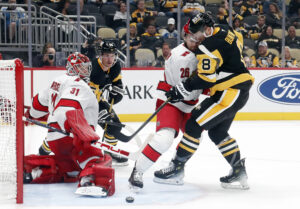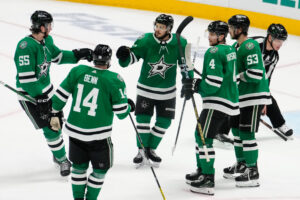The History of Trade is a mini-series going through each team’s best and worst trades of all time. Each team has their own history and some may cross over, but the series will try to stick to each team. This article will focus on the Toronto Maple Leafs trade history, finding the best and worst of all time.
Toronto Maple Leafs Trade History: Best and Worst Trades of All Time
There are many trades to choose from when considering the best and worst of this storied franchise. The Maple Leafs have employed some of the best and worst GMs. Their history of trading illustrates that well. The best trade was a no-brainer, but there were many trades to pick from for the worst.
Best Trade
Cliff Fletcher bringing Doug Gilmour to the team was the best thing that could happen to a franchise coming out of long, dark period under owner Harold Ballard.
The Trade
On January 2nd, 1992, the Calgary Flames traded Gilmour, Jamie Macoun, Ric Nattress, Kent Manderville and Rick Wamsley, to Toronto for Gary Leeman, Craig Berube, Michel Petit, Alexander Godynyuk and Jeff Reese.
Traded Away
Leeman was the centerpiece of the Leafs’ package. He scored 51 goals and 95 points in the 89-90 season. The following season he scored only 29 points in 52 games and had 20 points in 34 games when the Leafs traded him mid-season. Doug Risebrough, then GM and coach of Calgary, thought Leeman, a Western Canadian born kid, could regain his scoring touch with the likes of Joe Nieuwendyk, Sergei Makarov, Gary Roberts, Theo Fleury and Robert Reichel.
Berube was a bruiser that played only 40 games with the Maple Leafs but had 109 PIM in those games. He played only the rest of that season with the Flames and the next before moving on to the Washington Capitals for 6 seasons. He did return to the Flames in 2001-2002, for his final two seasons in the NHL.
Petit was an 11th overall pick in 1982. By the time he found himself on the Leafs, he was already playing for this 4th team. He went on to play for a total of ten different teams. He never scored more than 36 points in a season. Although he played in a career 827 games, only 134 were for the Flames.
Godynyuk was more of a prospect at the time of the trade with only 49 games played for the Maple Leafs. He played 33 for the Flames.
Each team included one backup goaltender. The Leafs sent Reese, a career back-up. At 24 was six year’s younger than his counterpart in the trade, Wamsley.
The Return
Gilmour won the Stanley Cup with the Flames in 1989 but was at odds with Risebrough after overhearing the GM claim he intended to trade the young superstar. Gilmour revealed that Risebrough was bitter after an arbitrator awarded Gilmour a salary of $625,000. The Flames were looking for $400,000 compared to Gilmour’s ask of $700,000.
A month after overhearing Risebrough, Gilmour decided to force his hand by threatening to leave the team to play for Team Canada. Gilmour’s threat, which he probably would have gone through with, may have had a role in the terrible return the Flames received.
Gilmour went on to become a fan favorite in Toronto. He scored an iconic goal against Curtis Joseph and the St. Louis Blues in a double overtime playoff game in 1993. He twice finished in the top four of Hart voting. Won the Selke in 1993, and was runner-up the next year. He scored 452 points in 393 games as a Maple Leaf and still holds the Leaf record for points in a single season with 127 in 1992-1993.
Macoun became a mainstay on the Leafs blueline for seven seasons. While not an offensive threat for the Leafs he came with a plus/minus of 210. He was a -37 with the Leafs in 466 games though.
Nattress was a tough defender but only played 36 games for the Leafs and 80 in total after leaving the Flames.
Manderville had yet to play an NHL game at the time of the trade. He played with the Leafs for four seasons, scoring 23 points in 136 games.
Wamsley played only 11 games as a Maple Leaf before retiring but returned to the team as a goalie consultant. He spent the next 6 seasons with the Leafs as a scout and coach.
Honorable Mention: On June 28th, 1994, the Leafs acquired Mats Sundin, Todd Warriner, Garth Butcher, a 1994 first round pick (Nolan Baumgartner, Washington Capitals) from the Quebec Nordiques for Wendel Clark, Sylvain Lefebvre, Landon Wilson and 1994 first round pick (Eric Fichaud).
Worst Trade
The Leafs have been known to give out first round picks like candy at Halloween, and October 1989 was no exception.
The Trade
On October 16, 1989, the Leafs traded their 1991 first round pick to the New Jersey Devils for Tom Kurvers
Traded Away
The Leafs gave up their first-round pick, third overall, in the 1991 entry draft. The Devils used that pick to select defenseman Scott Niedermayer who went on to win three Stanley Cups, the Norris trophy, and the Conn Smythe trophy. He played in 1263 games, scoring 740 points. None of them were for the Leafs, although many were against them. He was also instrumental in back to back playoff series victories over the Leafs in 2000 and 2001.
Other players, the Devils could have drafted with the third overall pick include Swedes Peter Forsberg and Markus Naslund. Considering the Leafs penchant for Swedish players, there is a good chance the Leafs would have taken Forsberg over Niedermayer. Had the Devils taken Forsberg, this would still be the worst trade in Leaf history.
The Return
Kurvers played a whopping 89 games for the Leafs, scoring 55 points before being traded to the Vancouver Canucks for Brian Bradley. Bradley played another 85 games for the Leafs before being lost in an expansion draft to the Tampa Bay Lightning.
Dishonorable mention: On June 24th, 2006, the Leafs acquired Andrew Raycroft from the Boston Bruins for Tuukka Rask.
Main Photo:






